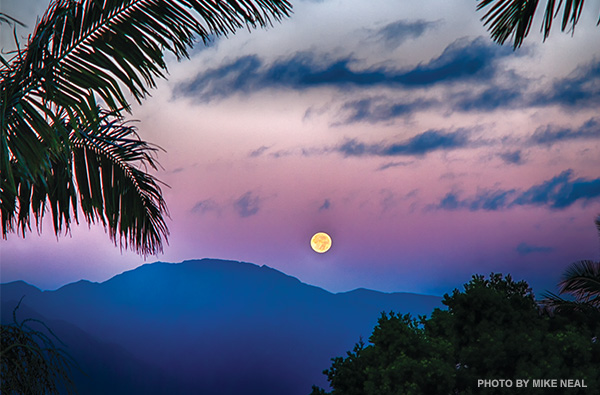Story by Teya Penniman | Photography by Mike Neal and Forest and Kim Starr

On a December eve, I step outside my North Shore home. The late-night moon plays coquette; swaths of passing clouds hide, then reveal her shape as she arcs toward the back of the West Maui Mountains. Her sunlit side swells toward half filled. “Crescent,” “gibbous,” “waning,” and a smattering of other descriptors comprise my vocabulary for changes in the moon’s luminosity, cycles that have played out hundreds of times around my spot on the planet. In old Hawai‘i, my ignorance would earn the scorn of the ‘olelo no‘eau (Hawaiian proverb) Kamali‘i ‘ike ‘ole i ka helu po: “Children who don’t know how to count the nights.”
For Hawaiians, such knowledge is more than a memory test. Based on generations of observations linking outcomes to celestial changes, kaulana mahina (the Hawaiian lunar calendar) tells when to plant which crops, identifies good times for harvesting, fishing or mending gear, and establishes kapu or sacred days for honoring the gods.
The Hawaiian malama (month) includes thirty phases, grouped into three ten-day periods: ho‘onui (growing bigger), poepoe (round or full) and emi (decreasing). I discover that my waxing moon is called ‘olekukahi. It’s one of seven phases beginning with ‘ole, a word meaning “nothing” or “without” that signals unproductive times for starting new projects, fishing or farming. If I’m planning to put fruit-bearing plants into the ground, I might want to wait ten nights for hua, named for its rounded egg shape, a night sacred to the god Lono, and good for many-seeded plants.
Online and print calendars provide easy-to-read charts, but it’s not that simple. “You have to pay attention to the seasons,” says Maui-born Kalei Nu‘uhiwa, the “queen” of the Hawaiian moon calendar. For her graduate studies, she plumbed old Hawaiian newspapers to understand how the calendar was woven into the fabric of life. She’s given countless presentations about the practice and makes the calculations for the annual Prince Kuhio Civic Club calendar. Nu‘uhiwa says, “For me, kaulana mahina has evolved into a tool that the everyday Joe can do just by paying attention to the environment. We become the experts.” Her passion for the practice and belief in community-based expertise come with a caveat.
“Kaulana mahina is a place-based tool,” she says. It requires practitioners to observe the world around them and to be clear about their objectives. She asks, “Are you on the dry side or wet side of the island? Do you want the leaves or the corm of the plant to be big? How much effort do you want to exert?” Calculations, timing and planting practices differ, depending on the answers.






Hawaiian Moon calendar:
When does each planting day start? Midnight, sunrise, sunset, moonrise, etc?